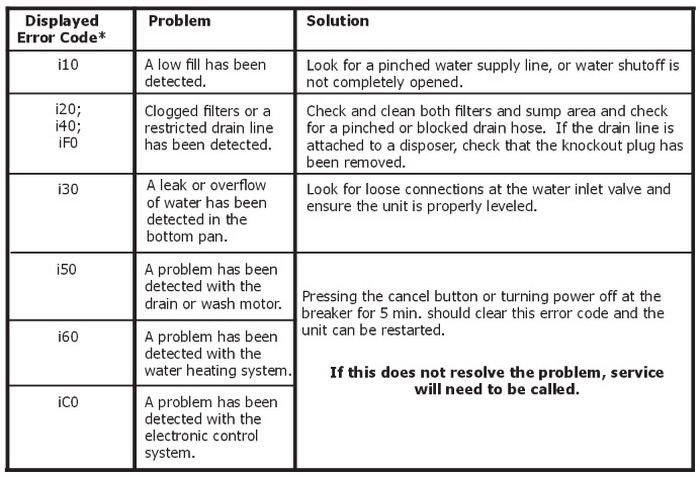
You might be asking, “What does resetting my dishwasher even mean, and how can it help?” Well, think of it as a way to give your dishwasher a fresh start. Imagine your dishwasher is a computer that’s been running too many programs and starts acting sluggish — a reset can clear the temporary glitches. In most cases, an F1 error can be caused by something minor, and a reset could potentially alleviate the issue without any further intervention. But let’s dig deeper into what this error really indicates and how a reset fits into the picture.
Understanding the F1 Error Code
First, let’s understand what this F1 code entails. The F1 error code on a Frigidaire dishwasher primarily relates to a problem with the appliance’s water system. Think of it like the plumbing in your home — if something is blocked or not functioning right, it tends to make a fuss. The F1 code usually indicates a water leak or an issue with the overflow protection system. Just like how a smoke detector blares when it senses smoke, the F1 code is a warning from your dishwasher’s internal sensors that something’s amiss.
Why does this happen? Well, it could be due to a variety of reasons. It might be a small leak somewhere in the system that you haven’t noticed, or perhaps a sensor inside the dishwasher has malfunctioned. Similar to how a car might light up its dashboard if a sensor detects an anomaly, your dishwasher does the same to prevent further damage. By understanding these signals, you can help troubleshoot your appliance effectively.
So, what’s the big issue? A continuous F1 error without resolution can lead to more significant problems, like water damage or an inoperable dishwasher. Hence, it’s crucial to address it sooner rather than later. If a reset doesn’t work, there may be a need for more thorough investigation, which we’ll discuss further on.
How to Reset Your Frigidaire Dishwasher
Now, onto the practical part — how exactly do you reset a Frigidaire dishwasher? It’s simpler than you might think. Like rebooting your computer, resetting your dishwasher can clear up minor glitches or system errors. Here’s the deal: All you generally need to do is disconnect the power. That’s right, unplug it like you would a lamp that’s acting funny, or turn off the circuit breaker if the plug isn’t easily accessible.
Once you’ve cut the power, wait around five minutes. This downtime allows the dishwasher to completely clear its memory, sort of like hitting a ‘refresh’ button. After the brief wait, restore power to the machine and turn it on. With any luck, the error code will have disappeared, and you’ll be able to run a new cycle.
If you’re still seeing that pesky F1 code, it might mean the issue lies deeper than a simple hiccup. Don’t give up hope yet — there are still a few more things you can try before calling in the professionals.
Troubleshooting Beyond the Reset
What if resetting doesn’t cut it? It might be time to roll up your sleeves and do a bit of investigation. Remember the plumbing analogy? Check around for any visible leaks around your dishwasher. Even a tiny crack in a hose can cause big problems. Feeling adventurous? Open up the dishwasher and ensure that the float switch isn’t stuck. This little component works like a float in the toilet tank and can trigger the F1 error if not in the right position.
Check if the water inlet valve is doing its job. Think of it like a gatekeeper to your dishwasher’s water supply. If it’s clogged or defective, it may need cleaning or replacement. Always remember to turn off the water supply before attempting any repairs — water everywhere isn’t a fun scenario!
Last but not least, if these steps haven’t resolved the F1 error, contacting a professional might be the best bet. While we all love a good DIY fix, some problems are better left to the experts to prevent further damage.
Preventative Measures for the Future
Prevention, as they say, is better than cure. To keep your Frigidaire dishwasher in tip-top shape and avoid error codes like F1, regular maintenance is key. Clean the dishwasher’s filter regularly to ensure no debris is blocking any parts. Just as you would clean your car’s engine for smooth running, your dishwasher needs similar care.
Make it a habit to check for leaks or unusual sounds every now and then. Addressing potential issues early can save you from bigger headaches down the road. And remember, a little tenderness goes a long way — avoid overloading your dishwasher, and use the appropriate amounts of detergent and rinse aid.
To sum up, while the F1 error can be an annoyance, it’s often manageable with the right steps. By understanding what this code means, trying a reset, and performing regular maintenance, you can keep your dishwasher running smoothly for years to come. So the next time that F1 code flashes, you’ll know just what to do!